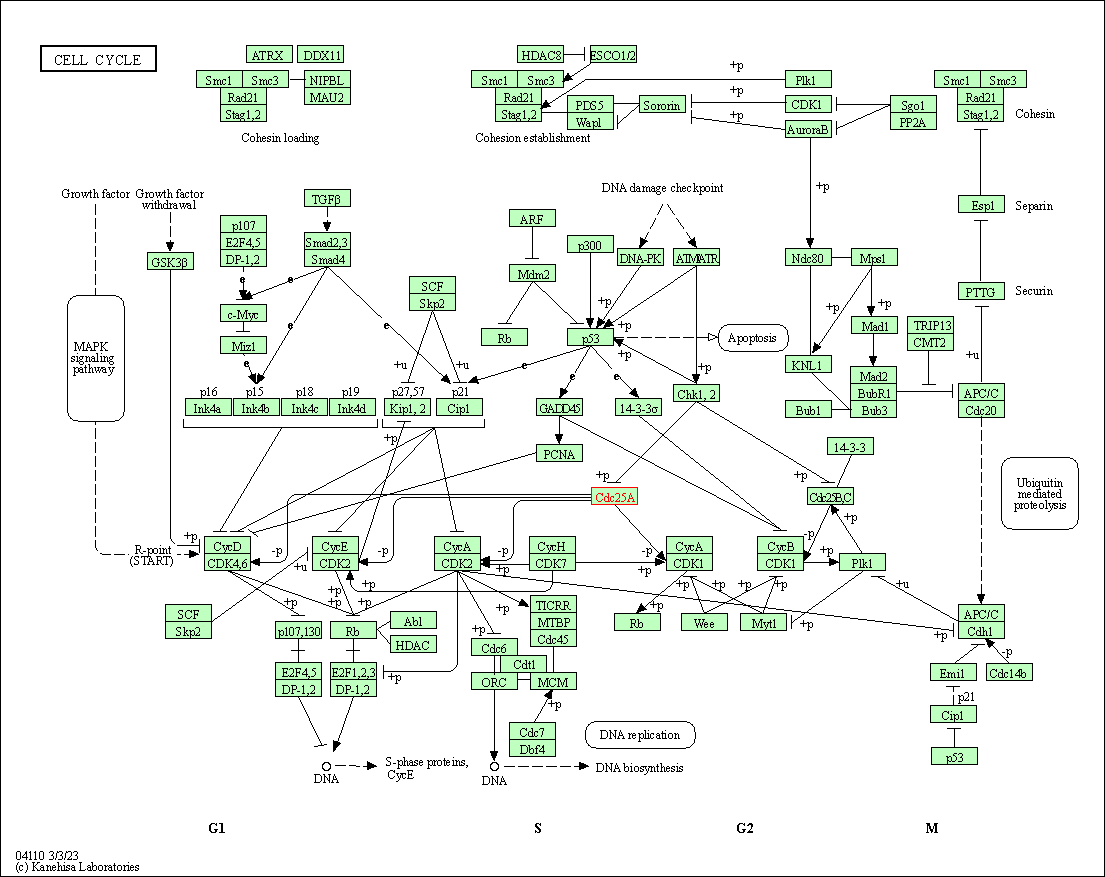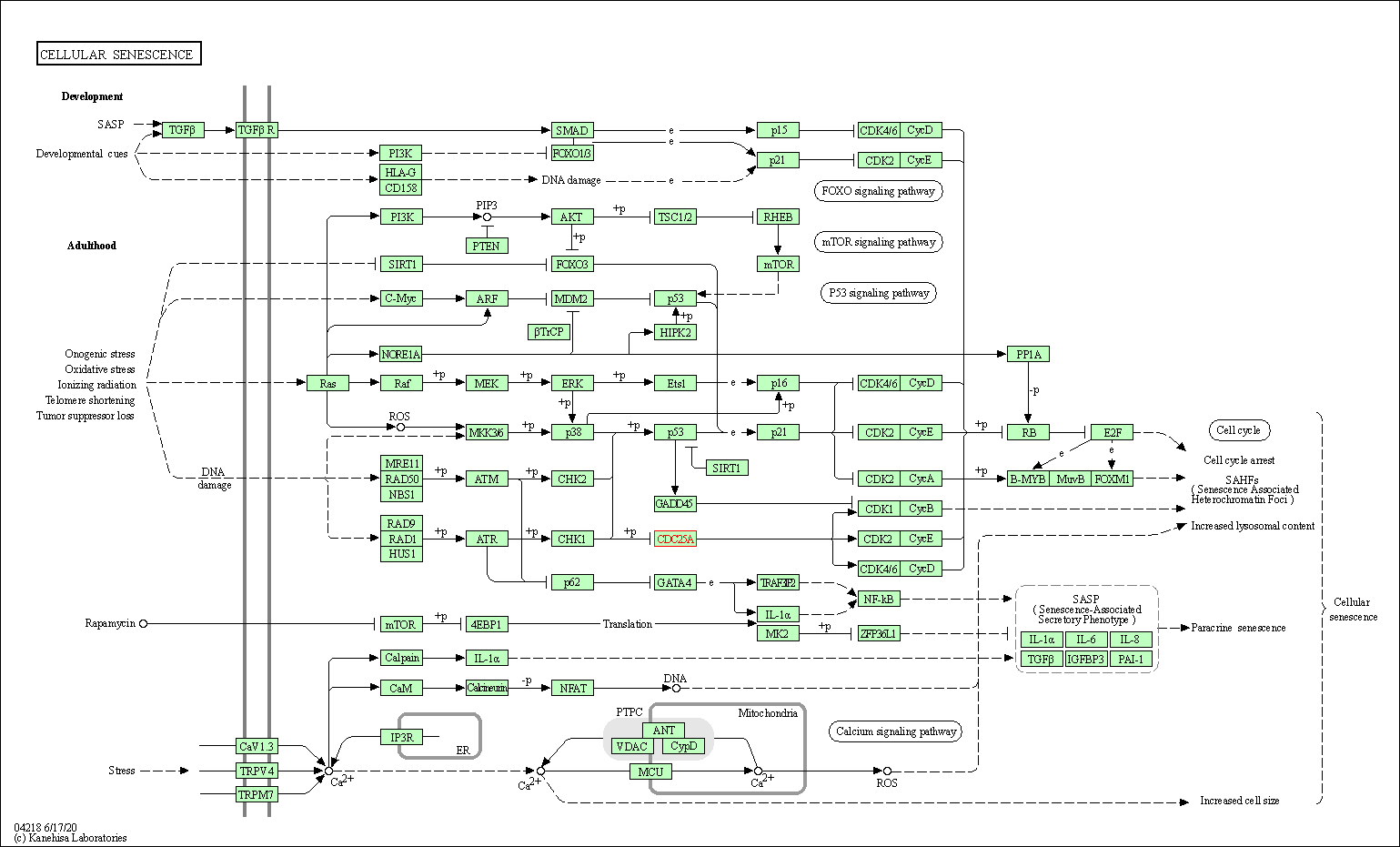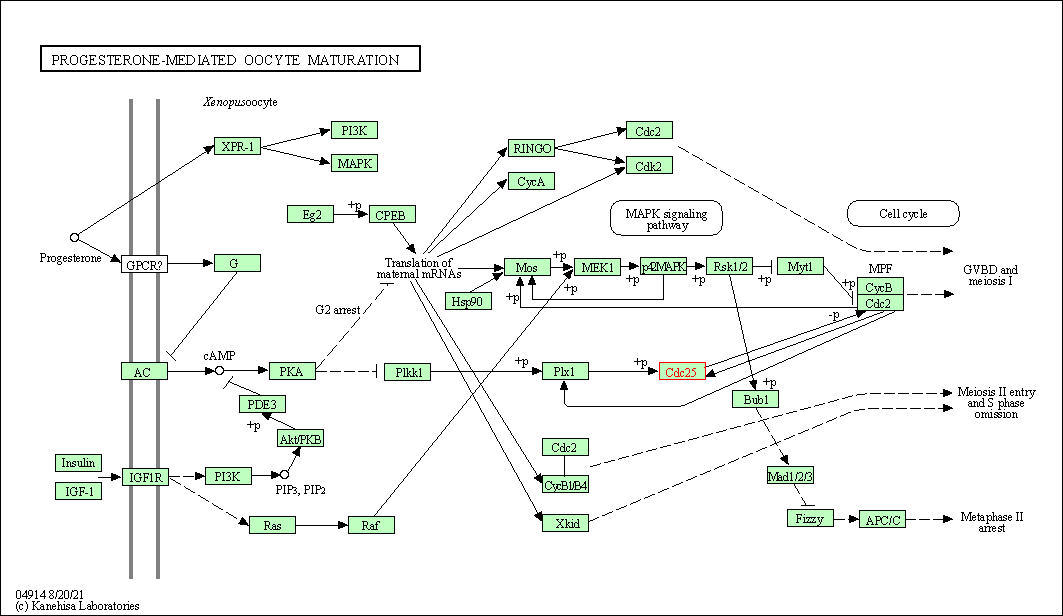Target Information
| Target General Information | Top | |||||
|---|---|---|---|---|---|---|
| Target ID |
T30823
(Former ID: TTDR00202)
|
|||||
| Target Name |
M-phase inducer phosphatase 1 (MPIP1)
|
|||||
| Synonyms |
Dual specificity phosphatase Cdc25A; Cdc25A phosphatase
Click to Show/Hide
|
|||||
| Gene Name |
CDC25A
|
|||||
| Target Type |
Literature-reported target
|
[1] | ||||
| Disease | [+] 2 Target-related Diseases | + | ||||
| 1 | Asthma [ICD-11: CA23] | |||||
| 2 | Solid tumour/cancer [ICD-11: 2A00-2F9Z] | |||||
| Function |
Directly dephosphorylates CDK1 and stimulates its kinase activity. Also dephosphorylates CDK2 in complex with cyclin E, in vitro. Tyrosine protein phosphatase which functions as a dosage-dependent inducer of mitotic progression.
Click to Show/Hide
|
|||||
| BioChemical Class |
Phosphoric monoester hydrolase
|
|||||
| UniProt ID | ||||||
| EC Number |
EC 3.1.3.48
|
|||||
| Sequence |
MELGPEPPHRRRLLFACSPPPASQPVVKALFGASAAGGLSPVTNLTVTMDQLQGLGSDYE
QPLEVKNNSNLQRMGSSESTDSGFCLDSPGPLDSKENLENPMRRIHSLPQKLLGCSPALK RSHSDSLDHDIFQLIDPDENKENEAFEFKKPVRPVSRGCLHSHGLQEGKDLFTQRQNSAP ARMLSSNERDSSEPGNFIPLFTPQSPVTATLSDEDDGFVDLLDGENLKNEEETPSCMASL WTAPLVMRTTNLDNRCKLFDSPSLCSSSTRSVLKRPERSQEESPPGSTKRRKSMSGASPK ESTNPEKAHETLHQSLSLASSPKGTIENILDNDPRDLIGDFSKGYLFHTVAGKHQDLKYI SPEIMASVLNGKFANLIKEFVIIDCRYPYEYEGGHIKGAVNLHMEEEVEDFLLKKPIVPT DGKRVIVVFHCEFSSERGPRMCRYVRERDRLGNEYPKLHYPELYVLKGGYKEFFMKCQSY CEPPSYRPMHHEDFKEDLKKFRTKSRTWAGEKSKREMYSRLKKL Click to Show/Hide
|
|||||
| 3D Structure | Click to Show 3D Structure of This Target | AlphaFold | ||||
| HIT2.0 ID | T08B2M | |||||
| Drugs and Modes of Action | Top | |||||
|---|---|---|---|---|---|---|
| Discontinued Drug(s) | [+] 2 Discontinued Drugs | + | ||||
| 1 | MX-7065 | Drug Info | Terminated | Solid tumour/cancer | [2] | |
| 2 | Ro 20-1724 | Drug Info | Terminated | Asthma | [3], [4] | |
| Mode of Action | [+] 1 Modes of Action | + | ||||
| Inhibitor | [+] 10 Inhibitor drugs | + | ||||
| 1 | MX-7065 | Drug Info | [1] | |||
| 2 | Ro 20-1724 | Drug Info | [5] | |||
| 3 | (E)-2-(1-decyl-2-oxoindolin-3-ylidene)acetic acid | Drug Info | [6] | |||
| 4 | 1-dodecyl-1H-indole-2,3-dione | Drug Info | [6] | |||
| 5 | 2-(1-dodecyl-1H-indol-3-yl)acetic acid | Drug Info | [6] | |||
| 6 | 3-isopropyl-4-(phenylthio)naphthalene-1,2-dione | Drug Info | [7] | |||
| 7 | 3-isopropyl-4-phenylnaphthalene-1,2-dione | Drug Info | [7] | |||
| 8 | 3-isopropylnaphthalene-1,2-dione | Drug Info | [7] | |||
| 9 | 4-(p-toluidino)-3-isopropylnaphthalene-1,2-dione | Drug Info | [7] | |||
| 10 | NSC-95397 | Drug Info | [8] | |||
| Cell-based Target Expression Variations | Top | |||||
|---|---|---|---|---|---|---|
| Cell-based Target Expression Variations | ||||||
| Different Human System Profiles of Target | Top |
|---|---|
|
Human Similarity Proteins
of target is determined by comparing the sequence similarity of all human proteins with the target based on BLAST. The similarity proteins for a target are defined as the proteins with E-value < 0.005 and outside the protein families of the target.
A target that has fewer human similarity proteins outside its family is commonly regarded to possess a greater capacity to avoid undesired interactions and thus increase the possibility of finding successful drugs
(Brief Bioinform, 21: 649-662, 2020).
Human Tissue Distribution
of target is determined from a proteomics study that quantified more than 12,000 genes across 32 normal human tissues. Tissue Specificity (TS) score was used to define the enrichment of target across tissues.
The distribution of targets among different tissues or organs need to be taken into consideration when assessing the target druggability, as it is generally accepted that the wider the target distribution, the greater the concern over potential adverse effects
(Nat Rev Drug Discov, 20: 64-81, 2021).
Human Pathway Affiliation
of target is determined by the life-essential pathways provided on KEGG database. The target-affiliated pathways were defined based on the following two criteria (a) the pathways of the studied target should be life-essential for both healthy individuals and patients, and (b) the studied target should occupy an upstream position in the pathways and therefore had the ability to regulate biological function.
Targets involved in a fewer pathways have greater likelihood to be successfully developed, while those associated with more human pathways increase the chance of undesirable interferences with other human processes
(Pharmacol Rev, 58: 259-279, 2006).
Biological Network Descriptors
of target is determined based on a human protein-protein interactions (PPI) network consisting of 9,309 proteins and 52,713 PPIs, which were with a high confidence score of ≥ 0.95 collected from STRING database.
The network properties of targets based on protein-protein interactions (PPIs) have been widely adopted for the assessment of target’s druggability. Proteins with high node degree tend to have a high impact on network function through multiple interactions, while proteins with high betweenness centrality are regarded to be central for communication in interaction networks and regulate the flow of signaling information
(Front Pharmacol, 9, 1245, 2018;
Curr Opin Struct Biol. 44:134-142, 2017).
Human Similarity Proteins
Human Tissue Distribution
Human Pathway Affiliation
Biological Network Descriptors
|
|
|
There is no similarity protein (E value < 0.005) for this target
|
|
Note:
If a protein has TS (tissue specficity) scores at least in one tissue >= 2.5, this protein is called tissue-enriched (including tissue-enriched-but-not-specific and tissue-specific). In the plots, the vertical lines are at thresholds 2.5 and 4.
|
| KEGG Pathway | Pathway ID | Affiliated Target | Pathway Map |
|---|---|---|---|
| Cell cycle | hsa04110 | Affiliated Target |

|
| Class: Cellular Processes => Cell growth and death | Pathway Hierarchy | ||
| Cellular senescence | hsa04218 | Affiliated Target |

|
| Class: Cellular Processes => Cell growth and death | Pathway Hierarchy | ||
| Progesterone-mediated oocyte maturation | hsa04914 | Affiliated Target |

|
| Class: Organismal Systems => Endocrine system | Pathway Hierarchy | ||
| Degree | 24 | Degree centrality | 2.58E-03 | Betweenness centrality | 1.97E-04 |
|---|---|---|---|---|---|
| Closeness centrality | 2.34E-01 | Radiality | 1.41E+01 | Clustering coefficient | 3.73E-01 |
| Neighborhood connectivity | 4.69E+01 | Topological coefficient | 1.20E-01 | Eccentricity | 11 |
| Download | Click to Download the Full PPI Network of This Target | ||||
| Chemical Structure based Activity Landscape of Target | Top |
|---|---|
| Drug Property Profile of Target | Top | |
|---|---|---|
| (1) Molecular Weight (mw) based Drug Clustering | (2) Octanol/Water Partition Coefficient (xlogp) based Drug Clustering | |
|
|
||
| (3) Hydrogen Bond Donor Count (hbonddonor) based Drug Clustering | (4) Hydrogen Bond Acceptor Count (hbondacc) based Drug Clustering | |
|
|
||
| (5) Rotatable Bond Count (rotbonds) based Drug Clustering | (6) Topological Polar Surface Area (polararea) based Drug Clustering | |
|
|
||
| "RO5" indicates the cutoff set by lipinski's rule of five; "D123AB" colored in GREEN denotes the no violation of any cutoff in lipinski's rule of five; "D123AB" colored in PURPLE refers to the violation of only one cutoff in lipinski's rule of five; "D123AB" colored in BLACK represents the violation of more than one cutoffs in lipinski's rule of five | ||
| Target Poor or Non Binders | Top | |||||
|---|---|---|---|---|---|---|
| Target Poor or Non Binders | ||||||
| Target Regulators | Top | |||||
|---|---|---|---|---|---|---|
| Target-regulating microRNAs | ||||||
| Target-interacting Proteins | ||||||
| Target-Related Models and Studies | Top | |||||
|---|---|---|---|---|---|---|
| Target Validation | ||||||
| References | Top | |||||
|---|---|---|---|---|---|---|
| REF 1 | Handbook of Assay Development in Drug Discovery, Lisa K. Minor, 2013. Page(11). | |||||
| REF 2 | Trusted, scientifically sound profiles of drug programs, clinical trials, safety reports, and company deals, written by scientists. Springer. 2015. Adis Insight (drug id 800016615) | |||||
| REF 3 | URL: http://www.guidetopharmacology.org Nucleic Acids Res. 2015 Oct 12. pii: gkv1037. The IUPHAR/BPS Guide to PHARMACOLOGY in 2016: towards curated quantitative interactions between 1300 protein targets and 6000 ligands. (Ligand id: 5258). | |||||
| REF 4 | Trusted, scientifically sound profiles of drug programs, clinical trials, safety reports, and company deals, written by scientists. Springer. 2015. Adis Insight (drug id 800003923) | |||||
| REF 5 | Role of the Cdc25A phosphatase in human breast cancer. J Clin Invest. 2000 Sep;106(6):753-61. | |||||
| REF 6 | Design and synthesis of N-alkyl oxindolylidene acetic acids as a new class of potent Cdc25A inhibitors. Bioorg Med Chem Lett. 2008 Jun 1;18(11):3350-3. | |||||
| REF 7 | Synthesis of miltirone analogues as inhibitors of Cdc25 phosphatases. Bioorg Med Chem Lett. 2006 Apr 1;16(7):1905-8. | |||||
| REF 8 | Structure-based de novo design and biochemical evaluation of novel Cdc25 phosphatase inhibitors. Bioorg Med Chem Lett. 2009 Aug 1;19(15):4330-4. | |||||
If You Find Any Error in Data or Bug in Web Service, Please Kindly Report It to Dr. Zhou and Dr. Zhang.

